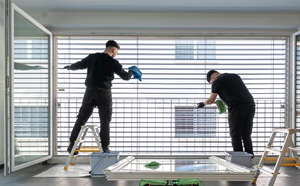5 essential health and safety tips for cleaners
In this article we'll cover:
- The importance of cleaner safety
- 5 methods of maintaining workplace safety
It is essential that every member of the workforce understands their role in how to maintain workplace safety. Cleaners are one group of staff who need to be aware of additional health and safety procedures and best practice, to ensure their own safety, as well as the safety of their colleagues and customers.
In this article we have provided an overview of five essential health and safety tips for cleaners. Each of these tips follow guidance from the Health and Safety Executive (HSE).
For more detailed training and guidance, please refer to our course on Health and Safety for Cleaners.

The importance of cleaner safety
Cleaners face risks and hazards ranging from musculoskeletal disorders to work-related skin disease daily. Work-related skin diseases include:
- dermatitis (dry, sore, flaky skin)
- eczema
- skin allergies
- asthma
- skin burns
- damage to the eyes
Did you know:
- Each year in the UK there is an estimated 8,000 new cases of self-reported skin disease that were caused or made worse by work.
- The leading causes for work-related skin disease in the UK are wet work and soap & cleaners.
- Approximately 4 million working days are estimated to be lost each year in the UK, owing to absenteeism resulting from work-related skin disorders.
It's essential that cleaners understand and follow procedures when using cleaning agents to prevent close contact with toxic or corrosive substances that can have a negative effect on their health.
What can cleaners do to maintain workplace safety?
1. Keep skin hydrated
It's vital that cleaners practice good personal hygiene to ensure a safe working environment, protect customers from illnesses, and prevent a loss of reputation for your organisation.
Personal hygiene refers to all the things we do to keep ourselves clean and healthy and protect ourselves from gastric infectious diseases, colds, and the flu.
Cleaners should be provided with the right PPE. Single-use gloves, should be thrown away after each task. Remember, gloves are not a replacement for hand washing. Cleaners must wash their hands both before and after using gloves to prevent the spread of bacteria.
Tip: If skin comes into contact with an allergen or irritant, we recommend rinsing the affected skin with warm water and an emollient (lotion, spray, cream – to soothe and hydrate the skin) as soon as possible. Emollients help prevent patches of inflammation and flare-ups of skin disease.
2. Prevent slips by restricting access
Cleaners must assess the risk from slips and trips and take reasonable precautions. Some simple things cleaners might consider as part of their assessment are spillages and wet or dirty floors.
Most slips happen on wet or dirty floors. Ensure cleaning happens at the right time and is carried out in the correct manner, using the right products and equipment for the job. Ensure wet floors signs are always used.
People often slip on floors that have been left wet after cleaning. Signs and cones only warn of a hazard, they do not prevent people from entering the area. If the spill is not visible, they are usually ignored.
Tip: If safe to do so, prevent access to smooth wet floors by using barriers, locking doors, or cleaning in sections.
3. Follow correct procedures
Following an effective cleaning procedure is vital for preventing health and safety risks. It ensures that harmful micro-organisms are fully removed, and not inadvertently spread, and that any additional risks are minimised. This has been particularly true during the Covid-19 pandemic whereby people have focused on the importance of cleanliness even more so than usual.
As a minimum, the government recommends wiping down frequently touched surfaces twice a day, and one of these should be at the beginning or the end of the working day.
Cleaning frequency should increase as the number of people using the space increases, whether they are entering and exiting the setting and access to handwashing and hand-sanitising facilities.
After you have finished the six stages of cleaning, the surface will be fully cleaned and most, or hopefully all, microorganisms will have been destroyed depending on which cleaning products you have used.
Tip: Reducing clutter and removing difficult to clean items can make cleaning easier.
4. Use containers
It is highly unlikely that any adult would ever think of drinking a cleaning substance intentionally, but it is still common to find food or drink containers being used to store hazardous cleaning substances. This should not be done.
Many cleaning companies will buy their cleaning products in bulk, and then decant them into smaller containers to take onto sites and cleaning jobs. Cleaners must follow their organisations procedures for decanting hazardous products and ensure that the allocated containers are used.
Tip: Make sure that all containers are appropriately labelled, it is safe to decant the chemical substance in question, nothing is unlabelled, and nothing from an unlabelled container is used.
5. Training and supervision
Organisations have a legal responsibility to ensure cleaners have a safe working environment. This means that cleaners are given appropriate training and personal protective equipment where required.
Are you confident that your employees and colleagues know how to follow your cleaning procedures and manage work-related risks?
Drive a safety culture with Access Learning
Find out more about our RoSPA and CPD Accredited eLearning content to help create a safer working environment across all sectors.
Online learning related to Health and Safety tips for Cleaners:
Access Learning offers a comprehensive catalogue of CPD and RoSPA accredited Health and Safety training, including:
Designed to be engaging and completed in the flow of work, our online Health and Safety courses covers topics from Cleaner Safety to Steward Training and includes categories such as Chemical Hazards courses, Food Safety & Hygiene and General Workplace Safety.



